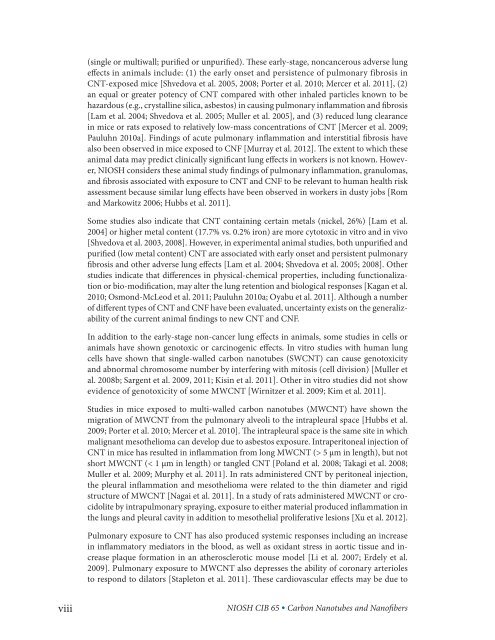Occupational Exposure to Carbon Nanotubes and Nanofibers
Occupational Exposure to Carbon Nanotubes and Nanofibers
Occupational Exposure to Carbon Nanotubes and Nanofibers
Create successful ePaper yourself
Turn your PDF publications into a flip-book with our unique Google optimized e-Paper software.
(single or multiwall; purified or unpurified). These early-stage, noncancerous adverse lungeffects in animals include: (1) the early onset <strong>and</strong> persistence of pulmonary fibrosis inCNT-exposed mice [Shvedova et al. 2005, 2008; Porter et al. 2010; Mercer et al. 2011], (2)an equal or greater potency of CNT compared with other inhaled particles known <strong>to</strong> behazardous (e.g., crys talline silica, asbes<strong>to</strong>s) in causing pulmonary inflammation <strong>and</strong> fibrosis[Lam et al. 2004; Shvedova et al. 2005; Muller et al. 2005], <strong>and</strong> (3) reduced lung clearancein mice or rats exposed <strong>to</strong> relatively low-mass concentrations of CNT [Mercer et al. 2009;Pauluhn 2010a]. Findings of acute pulmonary inflammation <strong>and</strong> interstitial fibro sis havealso been observed in mice exposed <strong>to</strong> CNF [Murray et al. 2012]. The extent <strong>to</strong> which theseanimal data may predict clinically significant lung effects in workers is not known. However,NIOSH considers these animal study findings of pulmonary inflammation, granulomas,<strong>and</strong> fibrosis associated with exposure <strong>to</strong> CNT <strong>and</strong> CNF <strong>to</strong> be relevant <strong>to</strong> human health riskassessment because similar lung effects have been observed in workers in dusty jobs [Rom<strong>and</strong> Markowitz 2006; Hubbs et al. 2011].Some studies also indicate that CNT containing certain metals (nickel, 26%) [Lam et al.2004] or higher metal content (17.7% vs. 0.2% iron) are more cy<strong>to</strong><strong>to</strong>xic in vitro <strong>and</strong> in vivo[Shvedova et al. 2003, 2008]. However, in experimental animal studies, both unpurified <strong>and</strong>purified (low metal content) CNT are associated with early onset <strong>and</strong> persistent pul monaryfibrosis <strong>and</strong> other adverse lung effects [Lam et al. 2004; Shvedova et al. 2005; 2008]. Otherstudies indicate that differences in physical-chemical properties, including functionalizationor bio-modification, may alter the lung retention <strong>and</strong> biological responses [Kagan et al.2010; Osmond-McLeod et al. 2011; Pauluhn 2010a; Oyabu et al. 2011]. Although a numberof different types of CNT <strong>and</strong> CNF have been evaluated, uncertainty exists on the generalizabilityof the current animal findings <strong>to</strong> new CNT <strong>and</strong> CNF.In addition <strong>to</strong> the early-stage non-cancer lung effects in animals, some studies in cells oranimals have shown geno<strong>to</strong>xic or carcinogenic effects. In vitro studies with human lungcells have shown that single-walled carbon nanotubes (SWCNT) can cause geno<strong>to</strong>xicity<strong>and</strong> abnormal chromosome number by interfering with mi<strong>to</strong>sis (cell division) [Muller etal. 2008b; Sargent et al. 2009, 2011; Kisin et al. 2011]. Other in vitro studies did not showevidence of geno<strong>to</strong>xicity of some MWCNT [Wirnitzer et al. 2009; Kim et al. 2011].Studies in mice exposed <strong>to</strong> multi-walled carbon nanotubes (MWCNT) have shown themigration of MWCNT from the pulmonary alveoli <strong>to</strong> the intrapleural space [Hubbs et al.2009; Porter et al. 2010; Mercer et al. 2010]. The intra pleural space is the same site in whichmalignant mesothelioma can develop due <strong>to</strong> asbes<strong>to</strong>s exposure. Intraperi<strong>to</strong>neal injection ofCNT in mice has resulted in inflammation from long MWCNT (> 5 μm in length), but notshort MWCNT (< 1 μm in length) or tangled CNT [Pol<strong>and</strong> et al. 2008; Takagi et al. 2008;Muller et al. 2009; Murphy et al. 2011]. In rats administered CNT by peri<strong>to</strong>neal injection,the pleural inflammation <strong>and</strong> mesothelioma were related <strong>to</strong> the thin diameter <strong>and</strong> rigidstructure of MWCNT [Nagai et al. 2011]. In a study of rats administered MWCNT or crocidoliteby intrapulmonary spraying, exposure <strong>to</strong> either material produced inflammation inthe lungs <strong>and</strong> pleural cavity in addition <strong>to</strong> mesothelial proliferative lesions [Xu et al. 2012].Pulmonary exposure <strong>to</strong> CNT has also produced systemic responses including an increasein inflamma<strong>to</strong>ry media<strong>to</strong>rs in the blood, as well as oxidant stress in aortic tissue <strong>and</strong> increaseplaque formation in an atherosclerotic mouse model [Li et al. 2007; Erdely et al.2009]. Pul monary exposure <strong>to</strong> MWCNT also depresses the ability of coronary arterioles<strong>to</strong> respond <strong>to</strong> dila<strong>to</strong>rs [Staple<strong>to</strong>n et al. 2011]. These cardiovascular effects may be due <strong>to</strong>viiiNIOSH CIB 65 • <strong>Carbon</strong> <strong>Nanotubes</strong> <strong>and</strong> <strong>Nanofibers</strong>

















